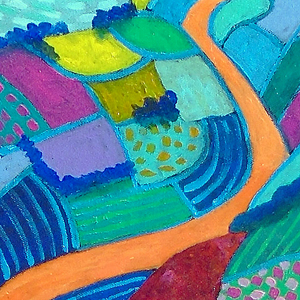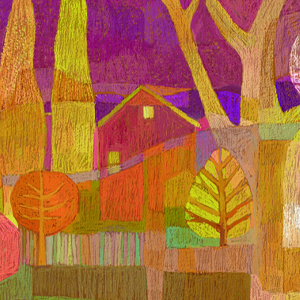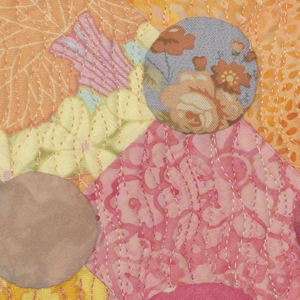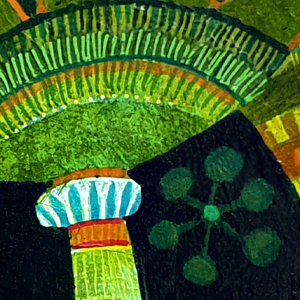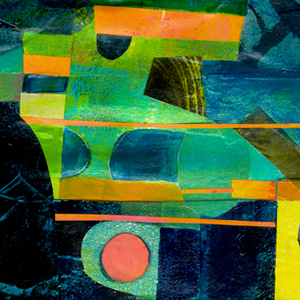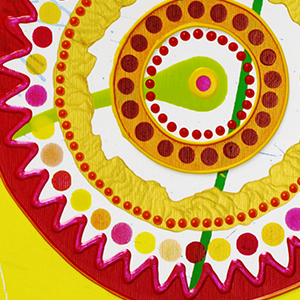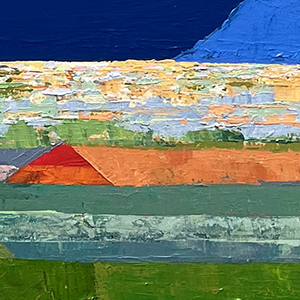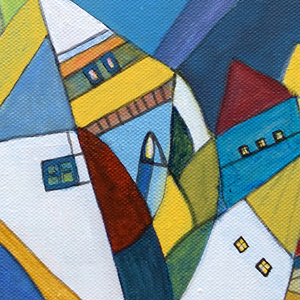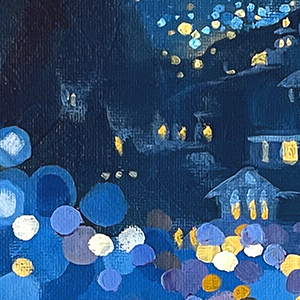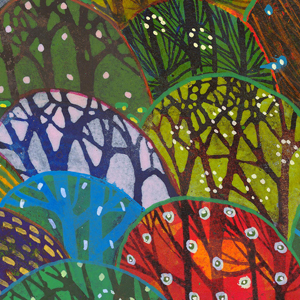
Defining Virtue
The Spirit of Freedom
Black Thought, Civic Virtue, and the Courage to Transform Democracy
Dayna L. Cunningham
Artwork: “Klein Karoo Sunset” by Jo Scott © 2023
Can courage of conviction co-exist with civic virtue? This seems to be a rather urgent question of our time. Achieving high-minded civic ideals is never easy, not least among those who have faced what Rogers Smith calls ongoing “civic estrangement,” an experience he says underlies the appeal of exclusionary populism, which it turns out, just won the last election.1 Salamishah Tillet describes this state for African Americans as “the protracted experience of disillusionment, mourning and yearning” that continued even after the Civil Rights Movement.
African Americans, are “simultaneously part of and tangential to the citizenry. . . subject to the continual repression of their economic and material contributions, [and] ‘busily disavowed’ in and by civic myths.”2 Yet, since the beginning of our republic, a distinct African American intellectual, moral, and cultural tradition has sought to reconcile the duality of unwavering belief in and advocacy for black freedom with the deep commitment to building robust and inclusive multi-racial democracy for all.
Two African American institutions, black universities (HBCUs) and the black church, have been paramount in this quest. Founded after the Civil War during a period of extreme violence against African Americans and division within the US, black colleges and universities have served as critical venues for preparing a dispossessed people to become active citizens in a troubled democracy. For the broader mass of African American people, the black church, once the sole institution for black learning, enabled the cultivation of a liberating spirituality to inform African American public and civic lives. Within these institutions’ traditions are found rich character and leadership development lessons for the present moment.
Like many black families, my own family history is imbued with influences from these institutions. My grandfather, William Wallace Brooks, left Virginia in 1914, during the ragged decades after the end of Reconstruction, when he was only 14 years old. At that time, vicious violence against African Americans was both random and endemic. My grandfather never talked about why he left home alone as a mere child. It might have been any number of things. My grandmother’s whole family moved North around that time after her older brother winked at a white woman. Or perhaps, he got a speck in his eye and blinked in the vicinity of a white woman. Whatever happened, facing the prospect of a lynching for disrespecting the virtue of a white woman, the entire family picked up and moved.
There is a part of my grandfather’s story that has always intrigued me: whatever caused him to leave Virginia, and whatever hardships he faced growing up on his own in the urban north, as an adult, one of his hobbies was writing patriotic songs—songs about the greatness of America, about its beauty and freedoms. Maybe for him, like many other immigrants who flee repression in their homeland, the North offered the absence of fear and that was enough. Yet, we know that the North presented its own challenges: among other things, my grandmother looked white, and at times they faced scrutiny as a supposed interracial couple.
I found my grandfather’s songs—handwritten sheets of music and lyrics that were a bit more like beer jingles than exultant paeans to his country—after he died. And I’ve always wondered what they meant to him. His brothers and sisters, my great uncles and aunts, stayed behind in the South, attended recently-founded black universities, became professionals, and eventually made their way North. They had stiff backs, big vocabularies, and a gravitas about them that I could not have described as a child. The men, especially, were given to holding court on wide-ranging topics of history and individual character at holiday dinners and family gatherings. Full of pride and optimism, they talked about what we ought to do. Perhaps like my grandfather, they read the dictionary daily, pronouncing the words as if they were lines of poetry.
I was fairly young when most of my grandfather’s siblings died, not old enough to ask who this we was. But when his younger brother died, we found among his things onion-skin papers of various proceedings of the Niagara Movement that seemed to be originals. A predecessor to the National Association for the Advancement of Colored People (NAACP), the Niagara Movement was named for the “mighty current of change” against segregation and disenfranchisement it hoped to create.3 Word had it that his eldest brother, Phillips Brooks, named after the famed Episcopalian theologian, had been involved.
My grandfather and his siblings came of age in the wake of a robust conversation among black educators and intellectuals, begun after the Civil War, about the intellectual, political, and moral future of African Americans. Even more than now, the nation was bitterly divided and there was no clear path forward for establishing a coherent American identity. As a people, African Americans were barely freed from the depredations of chattel slavery and they still lived with the betrayal of Reconstruction. They would need to become citizens in a shared effort of self-governance with people who, for generations, had treated them savagely. What’s more, if the country were ever to become the true democracy it said it wanted to be, using their first-hand experience with its abject failures, formerly enslaved people would have to help. They faced this in addition to a debilitating failure of democratic imagination in the larger society: for most whites, the idea of black people as fulsome members of the American civic body was inconceivable.
The black civic project thus demanded that African American–serving institutions inculcate at least three essential citizen capacities: criticality, compassion and imagination.
Douglass and Du Bois embodied the ethos of criticality. Their speeches and writings praise the “genius” animating American institutions while unsparingly denouncing their foundational flaws and racial authoritarianism. They characterize democracy as an idea or experiment, but not a reality. And they cast the Constitution and Declaration as instruments to achieve their goal of black freedom. Time and again, they return to the language of the documents and point out the rupture between the founding ideals and African American experience, advocating that the ideals should apply to African Americans as well.
In his monumental 1852 speech, “What, to the Slave, Is the 4th of July,” Frederick Douglass abundantly praises the founding fathers while fiercely condemning slavery: “[t]he right to hold and to hunt slaves is a part of that Constitution framed by the illustrious Fathers of this Republic.” He addresses his audience as “fellow citizens,” but makes plain that the freedom he hails on the 4th of July is theirs, not his own. For Douglass, the celebration of the holiday “only reveals the immeasurable distance between us.” Yet, “drawing encouragement from the . . . great principles” of the Declaration of Independence, Douglass warns, “the doom of slavery is certain.”4
Half a century later, in The Souls of Black Folk, Du Bois asserts that African Americans will have to “fight for the rights which the world accords to men, clinging unwaveringly to the great words” of the Declaration of Independence. He articulates a prominent role for black people, suggesting that they must study the problems of democracy, develop independent perspectives, and lead the South, “by candid and honest criticism, to assert her better self and do her full duty to the race she has cruelly wronged and is still wronging . . .”5 He proposes an active and transformative citizenship that pushes US institutions to end racial authoritarianism and fully extend democracy to all members of the polity. Carter Woodson, in Miseducation of the Negro, would further elaborate that this could not be accomplished unless black higher education achieved a distinct philosophical and ethical break from American educational traditions that historically justified subjugation.6 Along similar lines, Toni Morrison proposed that traditional scholarly fields could be enlivened in conversation with an African American studies discipline that invited purposeful engagement with the “black topic” at the heart of “every one of this nation’s mightiest struggles.” Such engagements could further criticality by helping to reveal “paradox, ambiguity . . . omissions, repetitions, disruptions, polarities, reifications, violence” within established academic discourses.7
Du Bois, and later Woodson, famously feuded with Booker T. Washington, the founder of Tuskegee Institute, over the purpose and direction of black higher education. In Tuskegee, Washington built a formidable institution to rigorously hone his African American students’ marketable technical skills as the pathway for black economic independence and social acceptance during the breakneck industrialization and wealth accumulation of the post-Reconstruction Gilded Age. While Washington created trailblazing programs—Tuskegee’s brickworks taught students an invaluable trade, and manufactured bricks for black schoolhouses around the US while generating a revenue stream to support the Institute; and its agricultural programs meaningfully improved productivity of farming practices across the South—his approach traded economic opportunity for political rights and full citizenship. In his speech at the Cotton States and International Exposition in Atlanta in 1895, he criticized African Americans’ quest for political gains during Reconstruction as driven by “ignorance and inexperience,” and asserted that “the wisest among my race understand that the agitation of questions of social equality is the extremest [sic] folly.”8 Du Bois contemptuously dismissed Washington’s Atlanta Exposition speech as the “Atlanta Compromise” (a sobriquet by which it is still known), calling Washington’s approach “civic death” for black people.9
For all of its critique, Du Bois opens Souls of Black Folk with the promise to “sketch . . . the spiritual world in which ten thousand thousand Americans live and strive.” [emphasis mine]. He identifies and articulates a particular African American sensibility: that formerly enslaved people bear a responsibility not only to themselves and the nation, or even to “the darker races of men whose future depends so largely on this American experiment,” but also, remarkably, to the children of the enslavers: “we have no right to sit silently by while the inevitable seeds are sown for a harvest of disaster to our children, black and white”10 [emphasis mine]. He locates the failure of the Reconstruction-era Freedman’s Bureau in the context of white Southerners facing “the spite and hate of conflict, the hell of war, when suspicion and cruelty were rife, and gaunt Hunger wept beside Bereavement.”11 While both Du Bois and Washington understood the political necessity of African Americans, as a small and marginalized minority engaging with a hostile majority, rather than Washington’s conciliation to the existing order, Du Bois proposes critique as well as compassion.
Cultivating compassion towards those who have inflicted great suffering requires a distinct kind of spiritual preparation. Martin Luther King’s teacher, Howard Washington Thurman, drew on deeply embedded values within black spirituality, to theorize a distinctive black theology. In Jesus and the Disinherited, Thurman said that Jesus, as a poor Jew in Rome, understood a lot about subjugation, and his teachings had special import for “those who stand, at a moment in human history with their backs against the wall.”12 These teachings weren’t based on the interpretations of the slaveholders, whose exhortation to turn the other cheek meant God wanted black people to accept inferiority and abuse, seeking respite in the afterlife. Instead, Jesus offered “a technique of survival of the oppressed”; a method to nurture inner resources in the face of violence and insecurity so as not to turn to hatred and violence themselves. “Hatred is destructive to the hated and the hater alike,” Thurman wrote.13 The inner work required is “a painstaking discipline, made possible only by personal triumph” over fear, hypocrisy and hatred so as to live in the present with dignity and creativity.14 The ethical demand of this discipline, which forms the foundation of the philosophy of non-violence, is the same for the powerful and the powerless, captured in Jesus’s admonition to love the enemy.
Beyond steely discipline and self-cultivation, the black civic project also demands abiding creativity. In Sites of Slavery, Tillet argues that for African Americans, civic estrangement gave rise to a unique kind of imagination imbued with criticality, a resource that drove the quest for black freedom. She cites Ralph Ellison, who said, “the society is not likely to become free of racism, thus it is necessary for Negroes to free themselves by becoming their idea of what a free people should be”15 (emphasis mine). Ellison’s observation is in some ways a response to the absences found in slave narratives, the earliest African American literature. So as not to offend white sensibilities, these accounts, in great demand during the height of the abolition movement, assiduously avoided mention either of the visceral brutalities of enslavement or the enslaved people’s own reflections on such cruelties. In her essay, “The Site of Memory,” Toni Morrison laments the “deliberate excising” of enslaved peoples’ self-reflection from the narratives they themselves told. In the quest in her own writing, to gain “total access to the unwritten interior life of these people . . . ,” she says, “only the act of imagination can help me.”16
Morrison also sees imagination as an essential practice for cultivating empathy, locating the source of racism itself in the “deplorable inability to project, to become the ‘other,’ to imagine her or him.”17 She specifically critiques scholars who dispassionately cataloged slavery’s barbarisms as inevitable requirements of the trade without any consideration of the humanity of enslaved people. In her 1988 commencement address to Sarah Lawrence College, Morrison implored students to hone their capacity to dream so as to enable them to “visualize the Other . . . ‘with unusual vividness, clarity, order and significance.’” This, Morrison says, is a necessary “preamble to problem solving” in the roles they will play as leaders making decisions about who will flourish and who will not.18
Our present moment, with heightening struggles over national identity and direction, great wealth disparities, and rising white nationalism, has resonance with the formative years of the black civic project. And in this context, a growing current within our field—reflected in changing university ranking systems19—to prioritize career readiness and increased earnings potential, though understandable in times of economic uncertainty, is cause for concern. The focus on social mobility is warranted given the current cost of a college degree. Yet, traces of the Washingtonian approach that Du Bois warned could risk civic death seem inescapable. Even elevated, highly marketable technical problem-solving skills taught in undergraduate and graduate classes today are insufficient without the higher-order discernment urged by Thurman. In an increasingly at-risk world, the instrumental approach will leave our students bereft of the leadership qualities and emotional/moral dispositions they’ll need to preserve human freedom and flourishing in real terms, not just as a hoped-for future state. The risk inevitably will grow more urgent as artificial intelligence fully takes hold.
In her Sarah Lawrence address, Toni Morrison helps us consider what we as educators should do. Humans, she says, are the “moral inhabitants of the galaxy” and we have a “magnificent obligation” to act with humanity. This requires disruption of a higher education ethos that “produce[s] generation after generation of people trained to make expedient decisions rather than humane ones.” We cannot be deterred by those who say that the world must remain the way it is. Instead, braiding together criticality, compassion and imagination, she argues, “it must be the way it ought to be.”20
Notes
- Smith, Rogers M., That Is Not Who We Are! Populism and Peoplehood, Yale University Press (2020).
- Tillet, Salamishah. Sites of Slavery: Citizenship and Racial Democracy in the Post-Civil Rights Imagination, Duke University Press (2012): introduction; p. 8, citing Cheng, The Melancholy of Race, sarahlawrence.edu/news-events/inauguration/events/media/salamishah-tillet-sites-of-slavery.pdf.
- Russell, Hope L. “The Niagara Movement.” Niagara Falls Regional Heritage Area,
discoverniagara.org/the-niagara-movement. - Douglass, Frederick. (1852), “What to the Slave Is the Fourth of July?” pbs.org/wgbh/aia/part4/4h2927t.html.
- Du Bois, W. E. B. The Souls of Black Folks, Signet (1969): pp. 91, 94–95). (Original work published 1903).
- Woodson, Carter G., “The Mis-Education of the Negro” (1933), in I. M. Zulu, ed., The Journal of Pan African Studies: 2009 eBook. jpanafrican.org/ebooks/3.4eBookThe%20Mis-Education.pdf.
- Morrison, Toni, The Source of Self Regard: Selected Essays, Speeches and Meditations. Alfred A. Knopf, Kindle ed. (2019): pp. 203–205, 160.
- Harlan, Louis R., ed., The Booker T. Washington Papers, Vol. 3, University of Illinois Press (1974): pp. 583–587.
- Du Bois, pp. 80, 91.
- Ibid. 91.
- Ibid. 67.
- Thurman, Howard, Jesus and the Disinherited, Beacon Press (1976): p. 11.
- Ibid. pp. 29–35.
- Ibid. p. 11.
- Tillet, introduction; p. 10, citing Ellison.
- Morrison, p. 237.
- Ibid., p. 43.
- Ibid., p. 69.
- See, e.g., “U.S. News Best Colleges,”
usnews.com/best-colleges, and “Wall Street Journal 2025 Best Colleges in the U.S.,” wsj.com/rankings/college-rankings/best-colleges-2025. - Morrison, pp. 71–73.
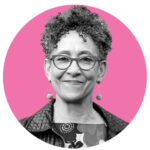 Dayna L. Cunningham is the Pierre and Pamela Omidyar Dean of Tufts University’s Jonathan M. Tisch College of Civic Life. The only university-wide college of its kind, Tisch College studies and promotes the civic and political engagement of young people at Tufts, in our communities, and in our democracy. Dean Cunningham joined Tisch College in 2021 after a distinguished career as a civil rights lawyer and founder of the Community Innovators Lab (CoLab) at the Massachusetts Institute of Technology (MIT).
Dayna L. Cunningham is the Pierre and Pamela Omidyar Dean of Tufts University’s Jonathan M. Tisch College of Civic Life. The only university-wide college of its kind, Tisch College studies and promotes the civic and political engagement of young people at Tufts, in our communities, and in our democracy. Dean Cunningham joined Tisch College in 2021 after a distinguished career as a civil rights lawyer and founder of the Community Innovators Lab (CoLab) at the Massachusetts Institute of Technology (MIT).
Spring 2025
Part I: Defining Virtue
James Arthur
Dayna L. Cunningham
Greg Lukianoff
Najeeba Syeed
Interlude: Defining Moments
Part II: Defining Vocation
MORE



